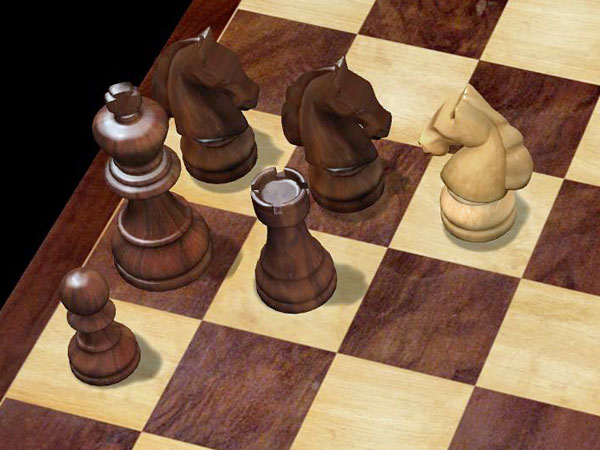
Don’t bother me with smother, mate!
By Siegfried Hornecker
At the same Congress where the idea for this column was conceived, a number of composing tourneys were held. I participated in several of them, but unfortunately because of a misunderstanding my entry for a two-mover tourney was at first not submitted and then didn’t fit the theme. In the studies tourney, I got more lucky – I did not win anything, but I had the pleasure of seeing a very beautiful study which I would love to share, here in a corrected version.

[Event "Jenever Tourney 2016, 1st prize {c}"] [Site "?"] [Date "2016.08.??"] [Round "?"] [White "Hlebec, Darko"] [Black "?"] [Result "1-0"] [Annotator "Hornecker,Siegfried"] [SetUp "1"] [FEN "6n1/kP6/P7/1p1r2p1/pP4K1/3B2Q1/p2R1p2/2r1R3 b - - 0 1"] [PlyCount "22"] [EventDate "2016.??.??"] {Black to move, White wins -- The position is a bit unnatural, but we will see that replaying the study is worth it. For now, Black must start with energetic moves, as otherwise White could just promote or take on c1/f2.} 1... Nf6+ 2. Kf3 ({After} 2. Kh3 $2 g4+ {the king must eventually go to g2, and then the promotion to knight on e1 is much better than in the solution.} 3. Kh2 Rh5+ 4. Kg2 fxe1=N+ 5. Kf2 Nxd3+ 6. Qxd3 (6. Rxd3 Ne4+ $19) (6. Ke2 Re5+ $19) 6... Rh2+ 7. Kg3 Rh3+ $19) 2... fxe1=N+ {Black has to promote to a knight. Please keep an eye on the route of this newly promoted piece.} 3. Ke2 Nd7 $1 {Black has defended for now, he threatens to promote on a1, so White must give a check. It should not matter where, but indeed only one square will be right.} 4. Qe3+ $1 ({If White doesn't close the e-file, Black has a check here later:} 4. Qf2+ $2 Rcc5 5. bxc5 a1=Q 6. c6+ Nc5 7. c7 Qe5+ 8. Kd1 Qxc7 $19 {when he wins sooner or later.}) 4... Kxa6 {White now faces the decision of how to play on: Give the check on e6? Sacrifice the bishop? Promote on b8?} ({Nothing is to be gained by the defense} 4... Rcc5 {anymore:} 5. bxc5 a1=Q 6. c6+ Nc5 7. c7 $18) 5. Bxb5+ $3 {The correct decision} (5. b8=N+ $2 Nxb8 $11) ({The computer line} 5. Qe6+ $2 Ka7 6. Qxd5 a1=Q 7. Be4 Qh8 $1 8. b8=Q+ Qxb8 9. Qxd7+ Qc7 10. Qd4+ Ka6 11. Qf6+ Ka7 12. Rd6 Qc4+ 13. Kf2 Nd3+ $1 14. Rxd3 Qc2+ 15. Kg3 Qc7+ 16. Kg4 Rc4 $1 $11 {ends in a draw.}) 5... Rxb5 6. Rxa2 ({After the "obvious"} 6. Rd6+ $2 {Black has an "unguarded guard", as Krabbé calls it:} Rc6 $3 7. Rxc6+ Kxb7 8. Qc3 Re5+ 9. Kf1 Rf5+ 10. Kxe1 a1=Q+ 11. Qxa1 Kxc6 12. Qxa4+ Rb5 $11 { and Black has erected a fortress.}) 6... Rc2+ 7. Rxc2 Nxc2 8. Qe6+ Nb6 $1 { The best defense.} ({There is no fortress after} 8... Kxb7 9. Qxd7+ Kb6 10. Qe6+ Ka7 11. Qc4 Re5+ 12. Kd3 Ne1+ 13. Kc3 $18) 9. Qc8 $1 {A standard manoeuver in such situations. If Black captures, White just gets the queen again, winning both knights. But what else is there to hope for, seeing as White can always promote to a queen? 9.-} Nxb4 $1 {Black just ignores it. If White really promotes to a queen, he only gets one knight, which is not enough to win. In fact, White has no possible way to win anymore with his king and queen against the Black army. So is it a draw?} 10. b8=N+ $1 Ka5 (10... Ka7 11. Qc7+ Ka8 12. Nc6 $18) 11. Qa6+ $1 {Notice my semantics. A queen might not be able to win. But a knight can. Black has no choice but to take the active piece.} Nxa6 12. Nc6# {[#]The theme of the tourney was smothered checkmate with a promoted knight. Liberally interpreted, Darko Hlebec decided Black also should have a promoted knight helping out. And isn't it the dream, anyway, of every chess player to deliver a smothered mate, and then maybe one as unexpected as this? Personally, I dislike the computer variations, the complicated sidelines, and probably our readers also will. But enjoying the play just on the main line, we have a typical Darko Hlebec machine where things are "forced" into place for the final aesthetics.} 1-0
|

You probably know that you can move pieces on our replay boards to analyse, and even start an engine to help you. You can maximize the replayer, auto-play, flip the board and even change the piece style in the bar below the board. At the bottom of the notation window on the right there are buttons for editing (delete, promote, cut lines, unannotate, undo, redo) save, play out the position against Fritz and even embed our JavaScript replayer on your web site or blog. Hovering the mouse over any button will show you its function. |
 Darko won a bottle of Jenever, the traditional prize for this annual tourney organized by the Alexander Rueb Union for Chess Endgame Studies (Dutch abbreviation: ARVES). Their website offers a lot of studies for the readers to watch, but some pages take – at least for me – very long to load. The complete award of the tourney, as well as another endgame study and some other composition tourneys can be found at the WCCC 2016 website. The theme here was a smothered mate that is executed by a promoted knight.
Darko won a bottle of Jenever, the traditional prize for this annual tourney organized by the Alexander Rueb Union for Chess Endgame Studies (Dutch abbreviation: ARVES). Their website offers a lot of studies for the readers to watch, but some pages take – at least for me – very long to load. The complete award of the tourney, as well as another endgame study and some other composition tourneys can be found at the WCCC 2016 website. The theme here was a smothered mate that is executed by a promoted knight.
Of course the theme of the smothered mate is old, reaching back at least to the beginnings of modern chess. As studies with a lot of analysis are boring to some readers, the following study (actually a direct mate, but also sound as a study), featuring some knights as well, will not need any analysis at all, and it also contains an idea that dates back to the beginnings of modern... shatranj.

[Event "British Chess Magazine"] [Site "?"] [Date "1890.??.??"] [Round "?"] [White "Meyer/Blathy, HFL/O."] [Black "Mate in 45"] [Result "1-0"] [SetUp "1"] [FEN "b2b3R/1np2pp1/2N5/n1PK4/pP3P2/N1k2p2/Rpp3p1/r1B2rq1 w - - 0 1"] [PlyCount "89"] [EventDate "1890.??.??"] {British Chess Magazine/7 stipulation: mate in 45.} 1. Nb5+ Kd3 2. Ne5+ Ke2 3. Nc3+ Kf2 4. Nd3+ Kg3 5. Ne4+ Kg4 6. Ne5+ Kf5 7. Ng3+ Kf6 8. Ng4+ Ke7 9. Nf5+ Kd7 10. Ne5+ Kc8 11. Ne7+ Kb8 12. Nd7+ Ka7 13. Nc8+ Ka6 14. Nb8+ Kb5 15. Na7+ Kxb4 16. Na6+ Kc3 (16... Kb3 17. Rxb2+) 17. Nb5+ Kd3 18. Nb4+ Ke2 19. Nc3+ Kf2 20. Nd3+ Kg3 21. Ne4+ Kg4 22. Ne5+ Kf5 23. Ng3+ Kf6 24. Ng4+ Ke7 25. Nf5+ Kd7 26. Ne5+ Kc8 27. Ne7+ Kb8 28. Nd7+ Ka7 29. Nc8+ Ka6 30. Nb8+ Kb5 31. Rxb2+ Nb3 32. Na7+ Kb4 (32... Ka5 33. Bd2+) 33. Nbc6+ Kc3 34. Nb5+ Kd3 35. Nb4+ (35. Ne5+ {} Ke2 36. Nc3+ Kf2 37. Nd3+) 35... Ke2 36. Nc3+ Kf2 37. Nd3+ Kg3 38. Ne4+ Kg4 39. Ne5+ Kf5 40. Ng3+ Kf6 41. Ng4+ Ke7 42. Nf5+ Kd7 43. Ne5+ Kc8 44. Ne7+ Kb8 45. N5c6# 1-0
Darko Hlebec (born 1984) is a Serbian endgame study composer talent and personal friend of your author, who met him first in person in 2013. Darko works as director of his private company when he isn’t composing.
H. F. L. Meyer (complete name: Heinrich Friedrich Ludwig Meyer, 1839-1928) was a German chess composer whose works belong to the classical heritage of chess composition. Sadly not much is known about him apart from chess.
Ottó Titusz Bláthy (1860-1939) was the engineer of many chess puzzles that work more like clockwork than like chess games. The above modification of a Meyer idea is one of his shorter (!) studies. As we can read in various Internet sources, not only in chess, but also in his inventions this engineering genius created never-seen-before machines, such as the modern electric transformer (with Miksa Déri and Károly Zipernowsky).
 |
About the author
Siegfried Hornecker (*1986) is a German chess composer and member of the World Federation for Chess Composition, subcommitee for endgame studies. His autobiographical book "Weltenfern" (in English only) can be found on the ARVES website. He will present an interesting endgame study with detailed explanation each month. |





















 Darko won a bottle of Jenever, the traditional prize for this annual tourney organized by the
Darko won a bottle of Jenever, the traditional prize for this annual tourney organized by the 





